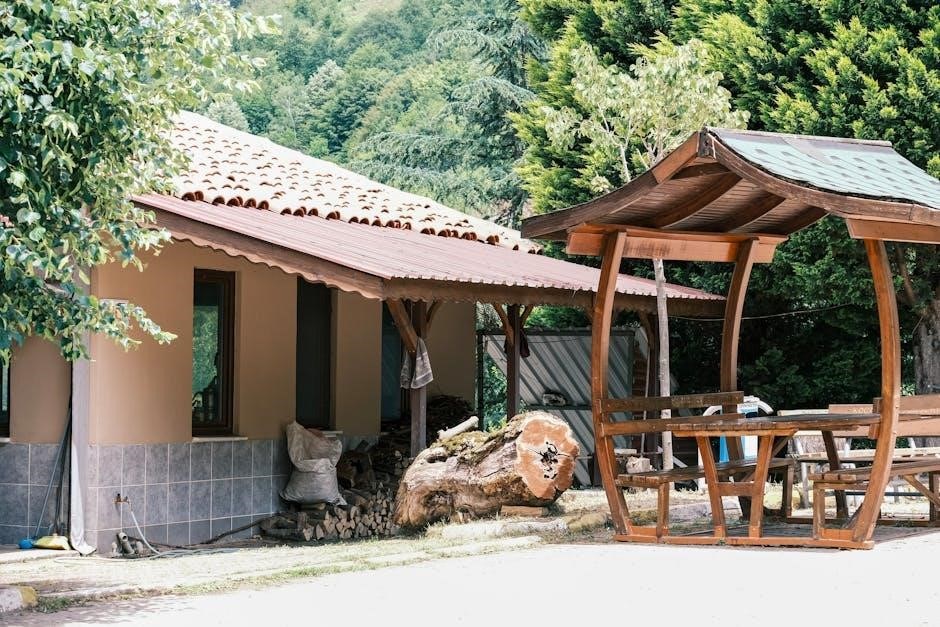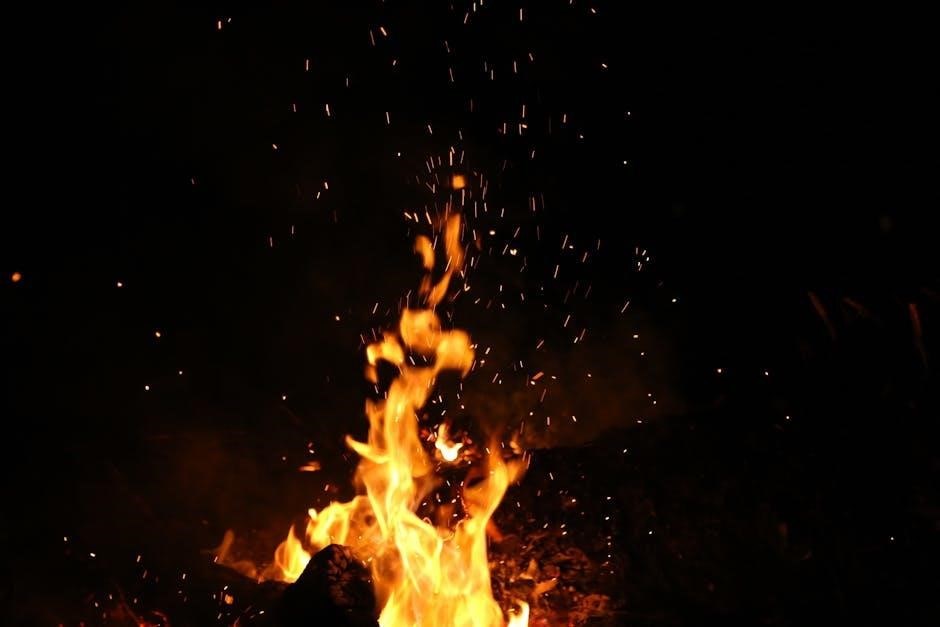A firewood BTU chart is a guide to measure heat output, helping users compare energy efficiency across wood species. It highlights moisture content impact and species variation.
Understanding BTU and Its Importance
BTU (British Thermal Unit) measures heat energy, specifically the energy required to raise one pound of water by one degree Fahrenheit. For firewood, BTU per cord indicates how much heat a wood species can produce. Higher BTU values mean more heat output, making certain woods like hickory and oak highly sought after. Moisture content significantly impacts BTU efficiency, as water evaporation consumes energy. Seasoned wood, with lower moisture, delivers higher BTU values. Understanding BTU helps users compare firewood species and determine the most efficient choice for heating needs. This metric is essential for maximizing heat output and energy efficiency.
Overview of Firewood BTU Charts
Firewood BTU charts provide a comprehensive comparison of heat output across various wood species. These charts list species alongside their BTU content, weight per cord, and moisture levels. By highlighting energy efficiency, they help users identify the best firewood for heating needs. Key data includes BTU per cord, species density, and heat value variations. Moisture content significantly impacts BTU ratings, as water reduces heat output. Charts often include species like hickory, oak, and maple, showcasing their superior heat values. This resource enables informed decisions for optimal wood selection, ensuring maximum heat output and energy efficiency. Variations in data reflect species-specific traits and regional differences.

Factors Affecting Heat Value of Firewood
The heat value of firewood is influenced by moisture content, wood density, and species variation. These factors significantly impact energy efficiency and combustion efficiency. Higher BTU values are typically found in drier, denser wood species.
Moisture Content and Its Impact
Moisture content significantly affects firewood’s heat value. Wood with higher moisture contains less usable energy, as BTUs are reduced when energy is spent evaporating water. Seasoned wood, typically with 20% moisture, burns more efficiently than green wood, which can have up to 50% moisture. The lower the moisture, the higher the heat output, as more energy is released for heating. Properly seasoned firewood ensures optimal combustion and maximizes BTU efficiency. Excess moisture reduces overall heat value, making it essential to store and season wood correctly before use. The ideal moisture level for firewood is between 15% and 20% for maximum energy output.
Wood Density and Species Variation
Wood density varies significantly across species, influencing heat value and burn efficiency. Denser woods, like hickory and oak, typically have higher BTU content, producing more heat per cord. Species like ash and maple also rank high, while softer woods such as pine or spruce yield lower BTUs due to lower density. This variation is crucial for selecting firewood, as denser woods burn longer and provide sustained heat. The BTU chart highlights these differences, helping users identify the most efficient options for their needs. Density and species are key factors in determining firewood’s energy output and combustion performance.

BTU Chart for Common Firewood Species
A BTU chart ranks firewood species by heat output, with hickory, oak, and maple among the highest. It helps users select efficient firewood for optimal heating.
Hickory, Oak, and Other High-BTU Woods
Hickory and oak are renowned for their high BTU content, making them top choices for firewood. Hickory typically offers 30-35 million BTUs per cord, while oak ranges from 28-32 million BTUs. These dense hardwoods burn slower and produce consistent heat. Other high-BTU woods include maple, ash, and beech, each providing over 20 million BTUs per cord. The higher heat value of these species is due to their dense structure and low moisture content when properly seasoned. This makes them ideal for efficient heating in wood stoves and fireplaces, ensuring maximum energy output with minimal waste.

Comparing BTU Values Across Species
Different firewood species vary significantly in BTU output. Hickory tops the list with 30-35 million BTUs per cord, followed by oak at 28-32 million. Maple and ash range from 25-28 million BTUs, while beech and birch offer slightly less. Softwoods like pine and spruce generally provide lower BTU values, around 15-20 million. Moisture content plays a crucial role, with seasoned wood producing higher BTUs. Comparing these values helps users select the most efficient firewood for their needs, ensuring optimal heat output and cost-effectiveness. This variation highlights the importance of choosing the right species for heating purposes.

How to Read a Firewood BTU Chart
Understanding a firewood BTU chart involves identifying species, their BTU values, and moisture content. It helps compare heat output efficiently for informed decisions on firewood selection.
Understanding the Data Presented
A firewood BTU chart presents data on heat value per cord, weight, and moisture content. Each species is ranked by BTU output, showing energy efficiency. The chart includes metrics like gross heating value and weight per cord, helping users evaluate wood performance. High-BTU species like hickory and oak are highlighted for maximum heat output. Moisture content is emphasized as a critical factor, with seasoned wood offering higher efficiency. This data aids in making informed decisions for optimal heating and resource management. By comparing values, users can choose the best firewood for their needs.
Interpreting Weight and Heat Value per Cord
A cord of firewood weighs between 2,000 to 4,000 pounds, varying by species. Heat value per cord is measured in BTUs, ranging from 14 million for aspen to over 30 million for hickory. Charts list species-specific data, showing weight and BTU content. For example, hickory weighs around 4,000 pounds per cord, delivering 30.6 million BTUs. This helps users assess energy output relative to weight, optimizing their fuel choice; Higher BTU values indicate greater heat potential, making certain woods more efficient for heating. Understanding this relationship is key to maximizing energy efficiency and cost-effectiveness.
Seasoning Firewood for Maximum Efficiency
Seasoning firewood reduces moisture content, enhancing heat output. Properly dried wood burns more efficiently, producing higher BTUs and minimizing smoke. This process is essential for optimal combustion.
The Role of Moisture in Heat Output
Moisture significantly impacts firewood’s heat output. High moisture content reduces BTUs, as energy is wasted evaporating water. Seasoned wood, with moisture levels around 20%, burns hotter and cleaner, optimizing combustion efficiency.
Best Practices for Seasoning Firewood
Seasoning firewood requires splitting logs into manageable sizes and storing them in a dry, well-ventilated area. Covering the top while leaving sides open prevents moisture retention. Ideal seasoning time is six months to a year, achieving moisture levels below 20%. Properly seasoned wood burns more efficiently, producing higher BTUs and reducing smoke. Regularly checking moisture levels ensures optimal results. This method maximizes heat output and minimizes environmental impact, making it a crucial step for effective firewood use.

Calculating BTUs per Cord
Calculating BTUs per cord involves determining the gross heating value for air-dry wood and adjusting for moisture content. Factors like species and weight impact results, ensuring accuracy.
Methods for Determining Heat Value
Determining heat value involves measuring a wood species’ energy content. Gross heating value is calculated for air-dry cords, typically ranging from 20-35 million BTUs. Species like hickory and oak often rank higher, providing over 30 million BTUs per cord. Moisture content significantly affects these values, as higher moisture reduces efficiency. The United Nations Wood Fuels Handbook suggests an average caloric value of 6,450 BTUs per pound at 20% moisture. Weight per cord also varies, with denser woods like beech and maple offering greater heat output.
Factors Influencing BTU per Cord
BTU per cord is influenced by moisture content, wood density, and species variation. Moisture content plays a crucial role, as higher moisture levels reduce heat output. Wood density varies among species, with denser woods like hickory and oak providing higher BTUs. Species-specific characteristics, such as chemical composition, also affect heat value. Additionally, the size and splitting of wood impact airflow and combustion efficiency, further influencing BTU output. Proper seasoning ensures wood reaches optimal moisture levels for maximum heat release, making it essential for efficient burning. These factors collectively determine the overall energy efficiency of firewood.

Maximizing Heat Output from Firewood
Maximizing heat output involves using well-seasoned, dry wood and proper species selection. Optimal moisture levels and efficient combustion practices ensure higher BTU release and better heating performance.
Optimal Wood Moisture Levels
Optimal wood moisture levels are crucial for maximizing heat output. Firewood with lower moisture content (15-20%) burns more efficiently, releasing higher BTUs. Green wood, with moisture above 30%, produces less heat due to energy spent evaporating water. Seasoning wood reduces moisture, enhancing combustion efficiency. The ideal moisture level for burning is 15-20%, as it balances heat output and burn time. Properly seasoned wood ensures better thermal performance, making it essential for achieving maximum heat from your firewood. Always check moisture levels before burning to optimize your heating experience and reduce smoke production.
Importance of Wood Size and Splitting
Importance of Wood Size and Splitting
Wood size and splitting significantly impact combustion efficiency. Properly split wood allows for better airflow, ensuring a more efficient burn. Logs should be split into sizes ranging from 3 to 6 inches in diameter to maximize exposure to oxygen. Larger pieces burn slower, while smaller pieces burn hotter but faster. The right size ensures a balanced burn, optimizing heat output. Splitting also helps reduce moisture content, as it exposes more surface area to dry. Uniformly sized firewood promotes consistent burning, making it easier to achieve higher BTU output efficiently. This practice enhances overall heating performance and reduces smoke production.
Understanding firewood BTU charts helps maximize heat output by selecting optimal species and ensuring proper seasoning, leading to efficient and effective heating solutions for any setting.
Key Takeaways from the Firewood BTU Chart
Firewood BTU charts provide essential insights into heat output variations across species, moisture content, and seasoning practices. They reveal that species like hickory and oak offer higher BTUs, while softer woods like aspen produce less heat. Moisture content significantly impacts efficiency, with properly seasoned wood (20% moisture) burning hotter than green wood. The charts also highlight the importance of wood density and size, as larger, well-split logs burn more efficiently. By understanding these factors, users can make informed decisions to maximize heat output and minimize waste, ensuring a more sustainable and cost-effective heating solution.
Using the Chart for Informed Decisions
The firewood BTU chart is a vital tool for making informed decisions about fuel selection and heating efficiency. By comparing BTU values, users can identify high-efficiency woods like hickory and oak, optimizing their heating needs. The chart also illustrates the impact of moisture content, emphasizing the importance of proper seasoning for maximum heat output. This data helps consumers make smarter purchases, ensuring they acquire wood that provides the best value and performance. Additionally, understanding weight and heat per cord enables better storage and usage planning, enhancing overall heating efficiency and cost-effectiveness.
